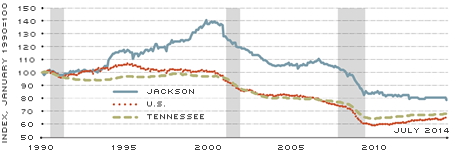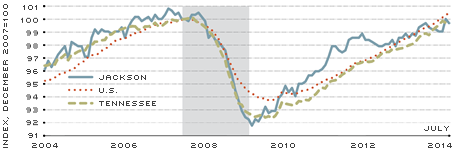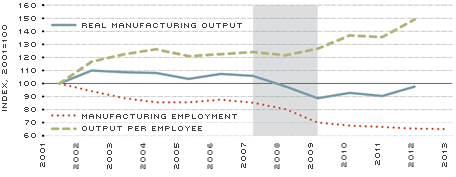Metro Profile: Manufacturing Shares the Stage with Service Sectors in Jackson, Tenn.
In western Tennessee, the area around Jackson has leveraged its manufacturing base to evolve into a center for services in the largely rural stretch between Memphis and Nashville.
Jackson experienced a manufacturing boom in the 1990s that set the stage for economic growth in the following decade and beyond. From 1990 to 2000, manufacturing employment in the two largest counties in the area—Chester and Madison—increased by more than a third, even as manufacturing employment nationwide fell slightly. Both population and nonfarm payrolls in Jackson grew faster than the national average during this period.
Jackson's road and rail connections, as well as its low rates of unionization and numerous state and local incentives, made it an attractive location for manufacturers; Jackson's position on Interstate 40 between Memphis and Nashville gives local companies access to the logistics and distribution network in Memphis and the growing markets and industrial base of the Nashville area. While manufacturing is still vital to Jackson's economy, in recent years the city has emerged as the center for services in this otherwise rural area.
The Jackson metropolitan statistical area (MSA), which now includes Chester, Crockett and Madison counties, has a population of about 130,650 people and a labor force of about 63,190. Between 2000 and 2013, the population of the MSA increased 7 percent, slower than the growth rates in both Tennessee (13.9 percent) and the nation (15.6 percent). Chester County, home to 13.3 percent of the MSA's population, grew the fastest (11.6 percent), followed by Madison County (7.2 percent), where the majority of the Jackson-area population resides. Crockett County registered growth of just 0.3 percent.
The borders of Jackson's MSA are in flux. Last year, the U.S. Office of Management and Budget added Crockett County to the area based on its increasing economic ties to Jackson. However, the Bureau of Labor Statistics (BLS) has yet to make the change, still considering the MSA to be made up of just Chester and Madison counties. Unless otherwise indicated in this article, the use of Jackson refers to the three-county area.
In 2013, Jackson's gross metropolitan product was $5.77 billion, about 8.5 percent of the size of the nearby Memphis economy and 5.7 percent of the size of the Nashville economy. Per capita personal income in Jackson grew 41.4 percent to $36,721 between 2002 and 2012, faster than the 37.6 percent growth rate for the nation. Although per capita personal income in Jackson is 16 percent lower than the national average, the cost of living is 18 percent lower.
In Madison County, 23.8 percent of those 25 and older hold a bachelor's degree or higher. In Chester and Crockett counties, 15.4 and 12.3 percent hold a bachelor's degree or higher, respectively. The average for the U.S. is 28.5 percent.
Economic Drivers
In 2000, manufacturing was the largest sector (by employment) in Madison and Chester counties, employing more than 20 percent of workers.1 Today, manufacturing is the third-largest sector by employment in this area and makes up 13.3 percent of total employment. (Still, the percentage is higher than the nation's 8.7 percent.) Manufacturers Delta Faucet, Kellogg, Pinnacle Foods, and Stanley Black and Decker are among the 10 largest employers in Madison County. The area continues to attract investment in manufacturing: The Jackson Chamber of Commerce reports that there was more than $1 billion in industrial investment between 2003 and 2013.
The education and health services sector has become increasingly important to the local economy. In late 2009, this sector surpassed manufacturing to become the largest private sector by employment in Madison and Chester counties. The majority of employees in this sector work in health care and social services. Jackson's health care providers have grown to serve the entire region between Memphis and Nashville: The Jackson chamber reports that more than 60 percent of the patients at Jackson's largest hospital are not from Madison County, where Jackson is the county seat. The largest employer by far in Madison County is West Tennessee Healthcare, which employs more than 5,000. Other top-10 employers in Madison County include Union University and the Regional Hospital of Jackson.
Although the rising importance of education and health care reflects Jackson's emergence as the hub for services in the area, it is also part of a national trend. Between 2003 and 2013, the sector grew 28 percent in Jackson's two largest counties and 25.6 percent nationwide. The sector accounts for about the same share of employment in the area (15.9 percent) as in the U.S. (15.5 percent).
Meanwhile, the public sector has been an important source of employment in Jackson for decades. Government became the largest sector by employment in Madison and Chester counties in late 2003, largely because of declines in manufacturing employment rather than increases in government employment. At the start of the recession in late 2007, government employment was 12,300; in March 2014, it was 12,700. The majority of government employees in the area work for local government. Three of the 10 largest employers in Madison County are in the public sector: the city of Jackson, Madison County government and the Jackson-Madison County School System. The Tennessee Supreme Court's courthouse for West Tennessee is also located in Jackson.
Current Conditions
At 7.8 percent in July 2014, the unemployment rate in the three-county MSA is higher than the nation's (6.2) and Tennessee's (7.1). However, the rate has fallen more quickly in Jackson than in the nation as a result of both increasing employment and a declining labor force. Between May 2013 and May 2014, Jackson's rate declined from 8.9 percent to 7.0 percent, while the U.S. rate declined from 7.5 percent to 6.3 percent. The unemployment rate in Jackson increased during the summer as the labor force grew faster than employment.
Nonfarm payrolls in Jackson's two largest counties grew much more quickly than the national average from October 2010 to February 2013. Most jobs added during this time were in the professional and business services sector. The education and health services sector also steadily added jobs during this time, as did the wholesale trade sector. Later in 2013, nonfarm payroll growth slowed to the national rate and has since dropped below that rate. Total employment has not quite recovered to its prerecession peak: In July 2014, total nonfarm employment was 0.3 percent below its level in December 2007.
Manufacturing employment in Chester and Madison counties has declined in year-over-year terms for the past six years. This mirrors the national trend. The declines in manufacturing employment could partly be a result of increases in efficiency: Jackson's manufacturing output in real terms in 2012 was only 2.4 percent below its level in 2001, when manufacturing employment in Jackson was near its peak. Although manufacturing employment has decreased significantly, Jackson continues to attract industrial businesses. According to figures from the Jackson chamber, new investment from existing industry in 2012 was above its 2003-2012 average. Two manufacturing companies have recently announced plans to expand or open new facilities in Jackson. Still, total business investment, which includes investment by newly recruited companies, has fallen over the past decade.
The education and health services sector experienced sustained growth between 2010 and 2012, but this growth has since slowed considerably. West Tennessee Healthcare has announced plans to cut positions, offer early retirement packages to hundreds of employees and reduce paid time off.
Going Forward
The diversification of Jackson's economy since 2000 has positioned it for moderate growth over the next 10 years, with the majority of employment growth likely to come from service industries.
Employment in Jackson's second-largest sector, education and health services, is expected to continue to grow nationally. The Bureau of Labor Statistics projects education services employment to grow by 1.9 percent and health care and social assistance employment to grow by 2.6 percent from 2012 to 2022. Over the past decade, Jackson's growth in these sectors has been consistently higher than national growth. If this trend continues, these sectors will provide many of the new jobs in Jackson over the next 10 years.
Employment in Jackson's third-largest sector, manufacturing, will likely remain relatively stable over the next decade. Manufacturing output may continue to grow, but productivity gains will allow manufacturers to produce more goods with fewer employees. The BLS predicts manufacturing employment nationwide will decline by 0.5 percent between 2012 and 2022, an improvement over the 2.4 percent decline in the previous 10 years. Jackson's rapid manufacturing growth bucked national and state trends during the '90s, but since 2000, developments in manufacturing employment in Jackson have mirrored the state and national trends.
Manufacturing Employment

Jackson Employment Shares

Nonfarm Payrolls

Jackson Manufacturing Productivity

NOTE: Real manufacturing output is the dollar value of manufacturing output in inflation-adjusted terms. Output per employee is real manufacturing output divided by the number of employees in manufacturing.
To see these charts with the latest data, as well as to see other data on the Jackson MSA, check out our data dashboard at http://research.stlouisfed.org/dashboard/872. In each of the four charts above, the gray bars represent recessions. The Bureau of Labor Statistics was a source for data in all four charts; in addition, Figure 4 used data from the Bureau of Economic Analysis. Employment data from the BLS Establishment Survey do not cover Crockett County.
MSA Snapshot
Jackson, Tenn.
| POPULATION |
130,645
|
| LABOR FORCE |
63,190
|
| UNEMPLOYMENT RATE |
7.8%
|
| PERSONAL INCOME (PER CAPITA) |
$36,721
|
| GROSS METROPOLITAN PRODUCT | $5.77 BILLION |
Nonfarm Employment by Sector

Largest Local Employers
| WEST TENNESSEE HEALTHCARE |
5,368
|
| JACKSON-MADISON COUNTY SCHOOL SYSTEM |
2,019
|
| DELTA FAUCET |
880
|
| UNION UNIVERSITY |
835
|
| KELLOGG | 735 |
Endnotes
- Employment data for the Jackson MSA come from the Establishment Survey of the Bureau of Labor Statistics and, therefore, do not include Crockett County. [back to text]
Views expressed in Regional Economist are not necessarily those of the St. Louis Fed or Federal Reserve System.
For the latest insights from our economists and other St. Louis Fed experts, visit On the Economy and subscribe.
Email Us



